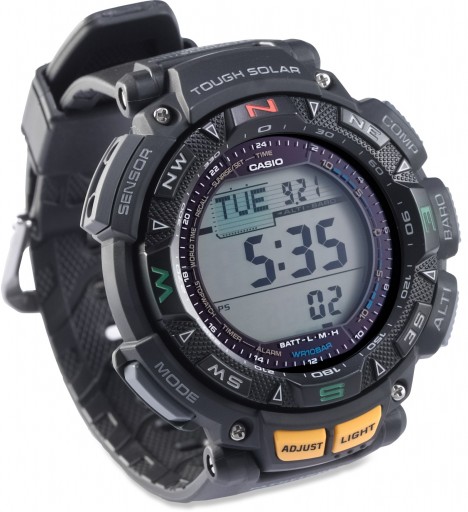Casio Pathfinder PAG240-1 Review
Our Verdict
Our Analysis and Test Results
Time
Both the Pathfinder PAG240-1 and PAG240T-7 have five alarms' two more than the Vector or Core. We rarely find a need for more than two alarms. The Pathhfinder has a stopwatch and a timer and when in stopwatch mode you can still see the time. Both models of Pathfinders come with 31 time zones (48 cities) in order to set sunrise/sunset alarms. This is a cool but not must-have feature. The Core also has a similar sunset/sunrise alarm with 400 locations programmed, the Vector has no such feature.
Altimeter
Both the Pathfinder PAG240-1 and the PAG240T-7 models measure altitude in 20-foot or 5-meter increments. We found it to be relatively accurate compared to other barometrically based altimeters. It scored well in our tests but not as high as the Suunto Core, which is accurate to one meter. A feature the Core also has on the Pathfinder is the ability to differentiate between barometric pressure changes from weather and changes from gaining or losing elevation.
The altimeter memory will hold up to 40 records of altitude, date, month and time (Suunto models hold 100 logs).
Barometer
The barometer function graphs the pressure to tell you what the weather is trending towards. This is a cool and easy to understand feature and the graph was way better than the one on the Sunnto Vector.
Compass
You can adjust the compass to each map's angle of declination. It can also help keep you on track by holding your bearing. As with all altimeter watches we tested, we don't recommend relying on the compass feature for serious off-trail travel (bring a real compass). It is more for a general point of reference.
Solar Power
The coolest thing about the Pathfinder is that it's solar powered. It has a thin strip of solar cells that circle around the outside of the screen that keep it powered indefinitely. Comparatively, the Vector gets about 18 months of power and the Core only about 12 months of running time. We never had a problem with the Pathfinder not absorbing enough light, both in the field and in day-to-day use. Casio claims that the Pathfinder could go six months without seeing light, pretty nice if you are someone who doesn't use their watch that much — stores it in the closet and breaks it out only now and again.
Thermometer
The thermometer only goes from 14F to 140F; we wished it would go down a little lower. Both the Vector and the Core went -5F to 140F. As with all the watches we tested, you can't use the thermometer while it is on your wrist.
Ease of Use and Interface
We really liked the nicely labeled buttons. which are easy to read and help identify function options. On a funny note, it took a few of our testers a couple minutes to realize the black sensor was not a button. Navigating in each menu option wasn't quite as easy as in other models we tested but wasn't hard. Similar to the competition, the Pathfinder generally gives you three pieces of information displayed at the same time. There is a graph in the upper left corner that also shares information depending on what you are doing. We thought this graph was way better than the one found on the Suunto Vector and as good as the one on the Suunto Core. The Pathfinder graph is way easier to get to than the Core, which involved several menu pages.
Display
Both Pathfinder models had by far best back light in the review. It crushed the competition as far as how easy it was to turn the light on as well as how bright it made the screen. In very bright light (i.e. on snow) the Pathfinder was easier to read than the Suunto Core and nearly as good as the Vector. The Pathfinder lays one screen over the other to make seeing the information you want easier to see. This is effective although at first, it seemed unnecessarily complicated and confusing.


